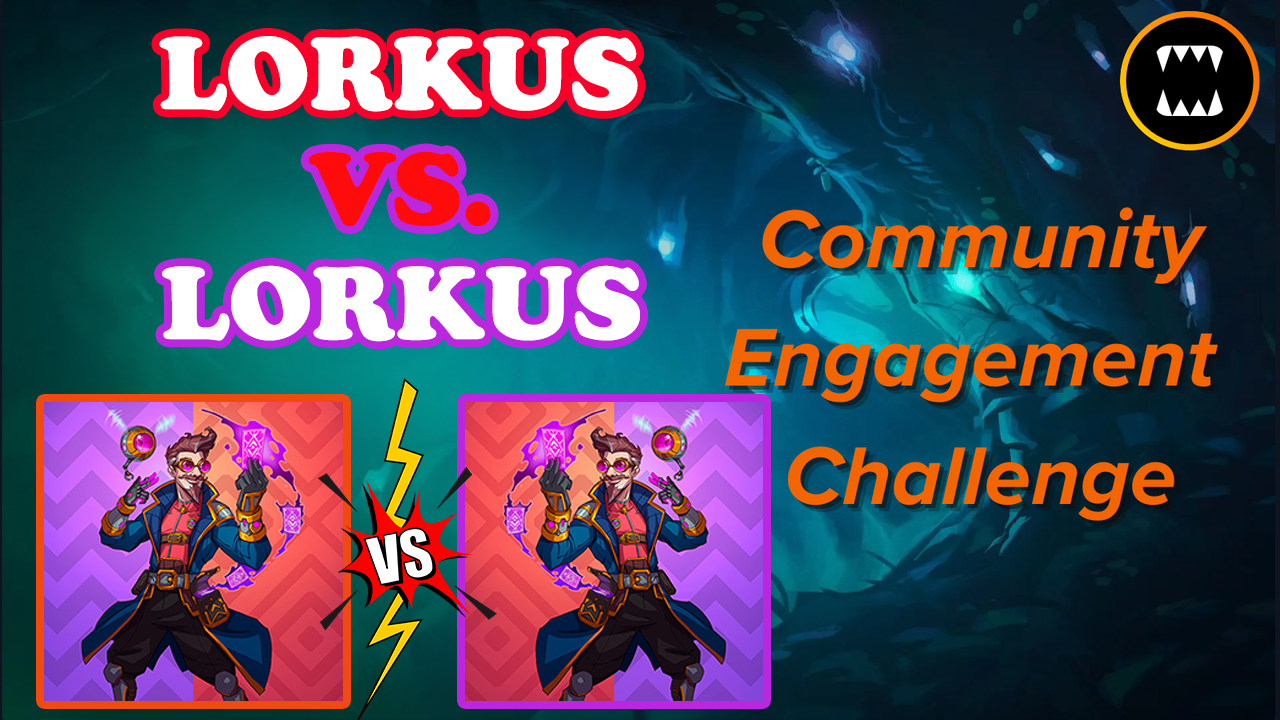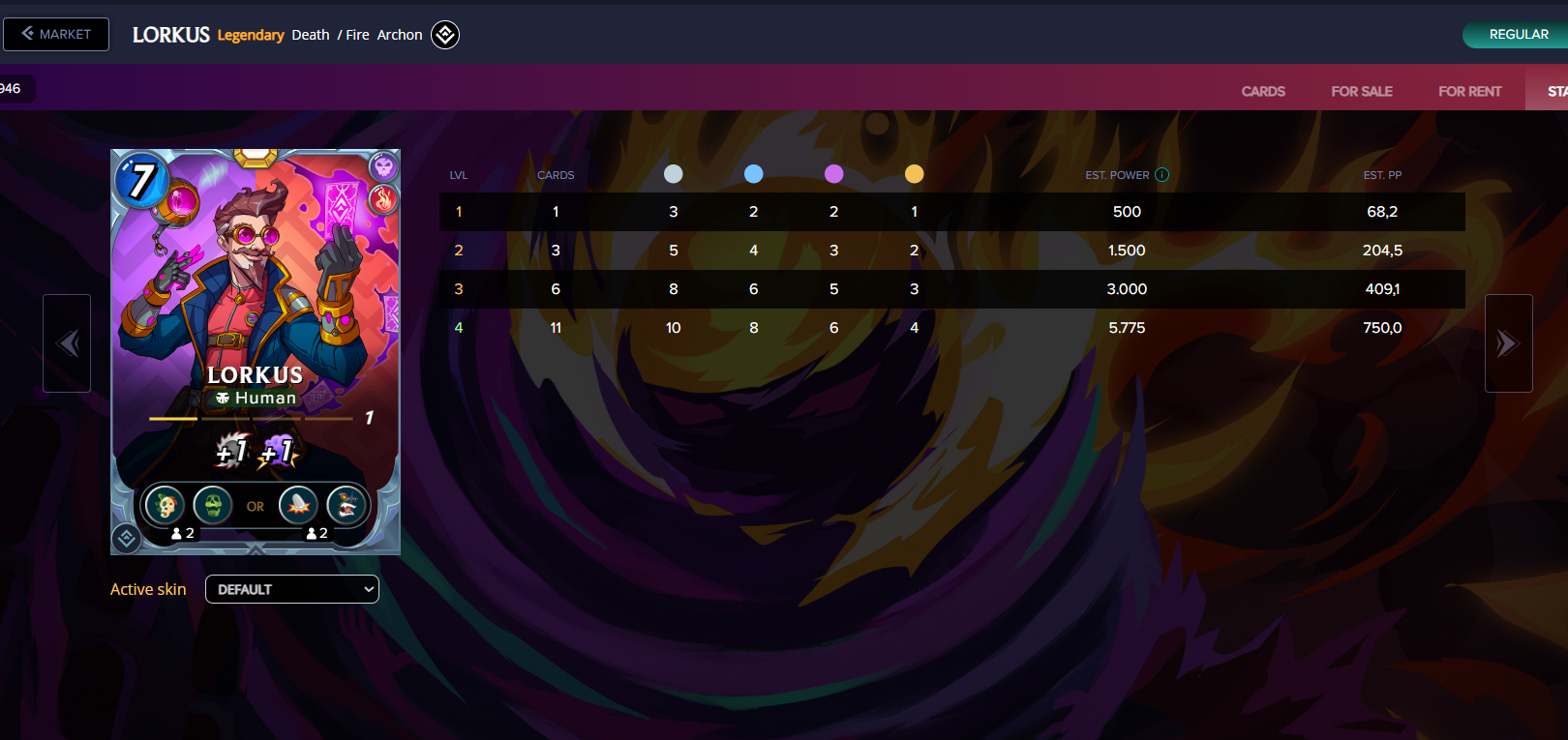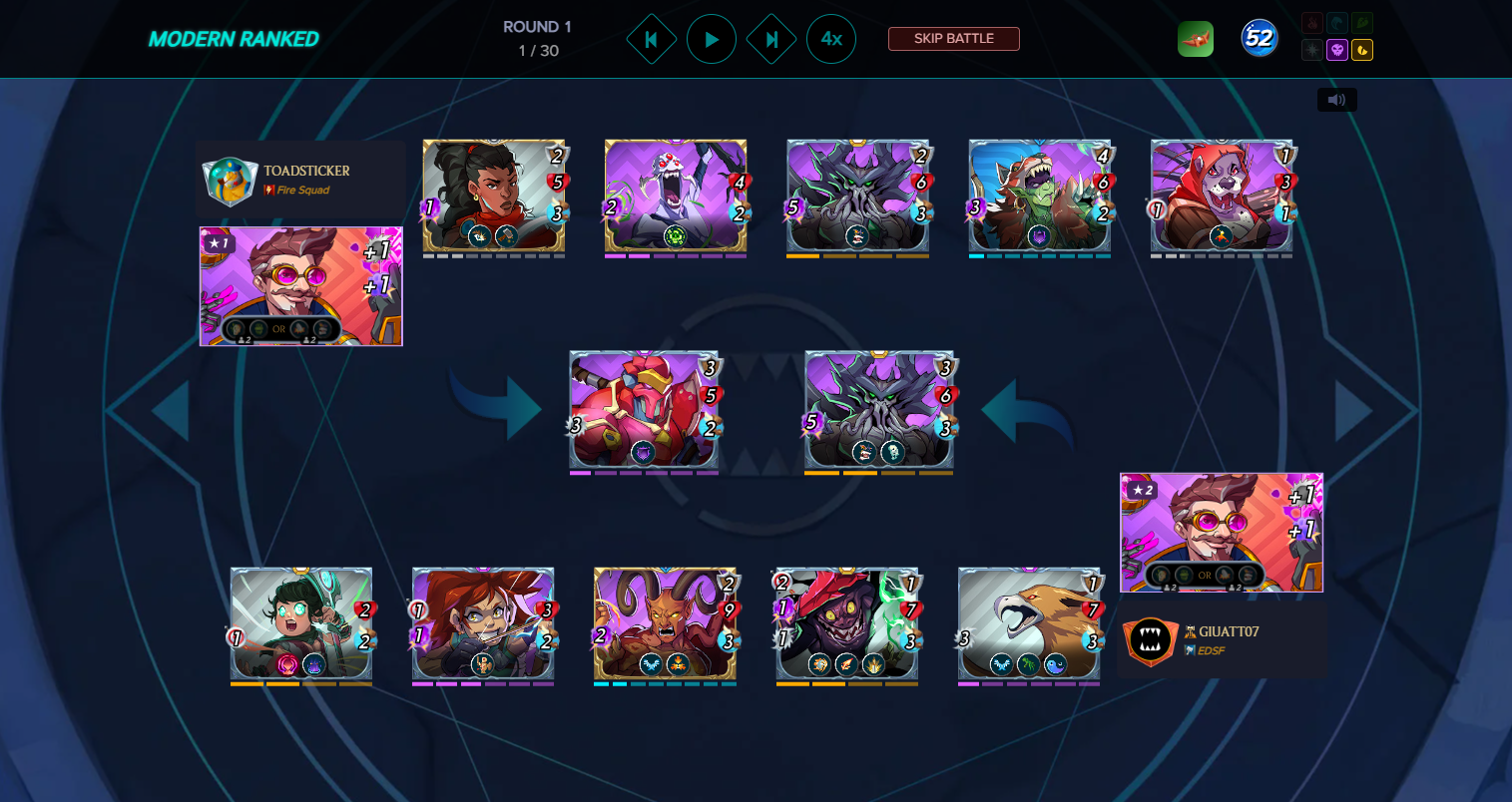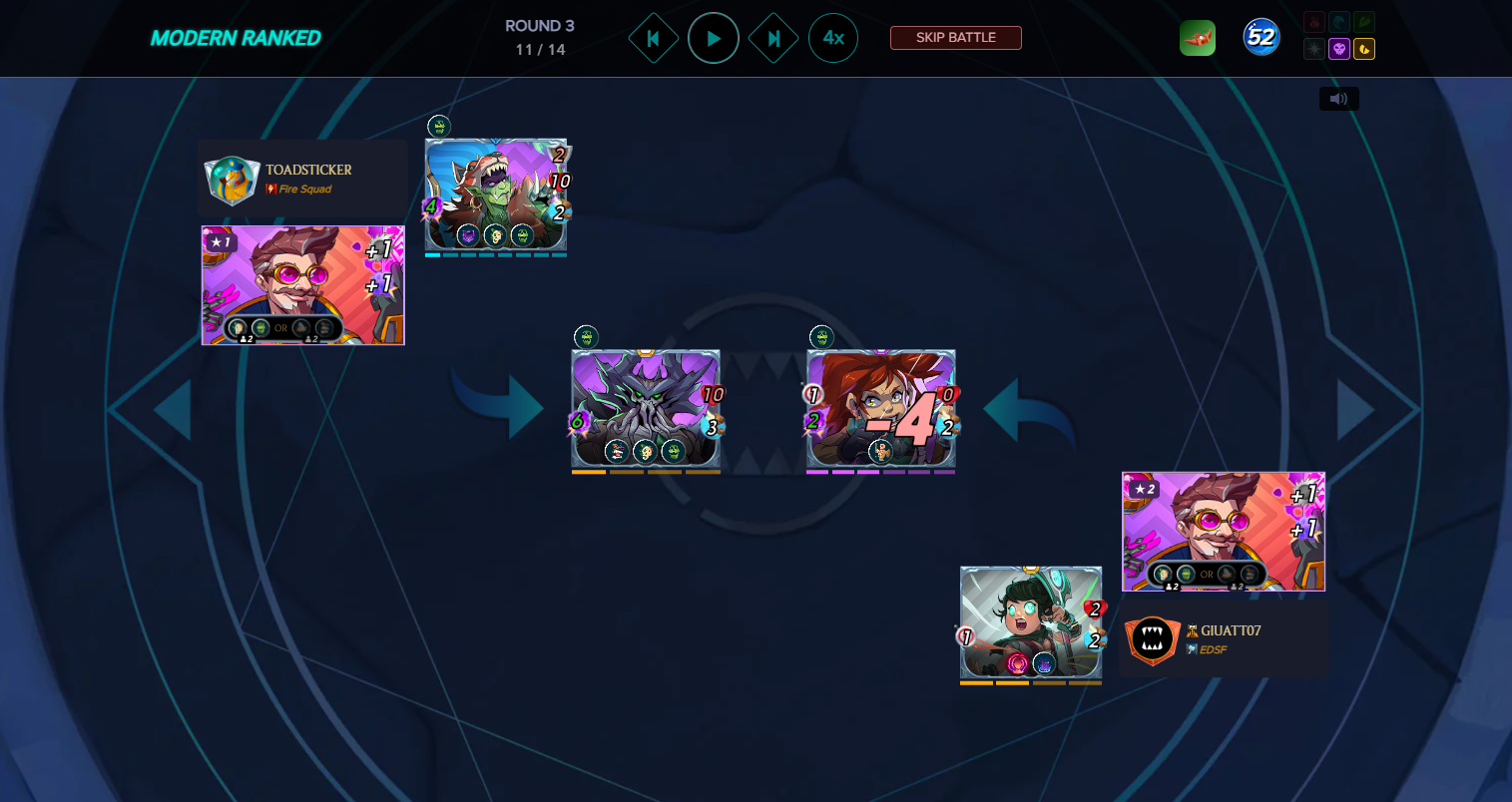
Hello everyone, friends of Splinterlands !!!
The theme of this week's Community Engagement Challenge is Battlefield Breakdowns!, which means writing a post about a recent battle that caught your interest, analyzing it carefully and highlighting for the reader all the various gameplay aspects, in order to understand which choices were winning, and which, instead, should be improved.
Those who read my posts already know it, my favorite Archon, especially in the Modern format, has now become Lorkus, and I almost pick him by default: this is an attitude that affects many players, who get attached to a particular Archon, and a certain card configuration, and choose it automatically, neglecting to study carefully the ruleset of that specific battle.
In the lower leagues this approach may go unnoticed, but as you climb higher and opponents become more competitive and prepared, relying on the same Archon can easily turn into a big disadvantage.
More experienced players know that the real key to victory does not lie in a single favorite Archon, but in the ability to adapt to every ruleset. Ignoring the specific rules of a battle, blindly trusting our "trusted friend", means giving a huge advantage to the opponent even before the battle begins. In the higher leagues, where every choice matters and opponents are ready to exploit the smallest weakness, tactical immobility is no longer an option.

Here it is, Lorkus, one of the most valued Archons, after Eternal Tofu, regarding the Modern format, with a current cost per BCX around 35 $, so leveling him up is not cheap at all, to reach level 4 it takes about 385 $.
This Archon immediately boosts the attacks of the whole team: +1 Melee and +1 Magic give a boost to all your monsters, often devastating for the opposing team.
But then, during the Tactics Stage, we have the chance to choose whether to grant the abilities Affliction and Life Leech or Fury and Trample to two teammates: I almost always pick the first combination, giving Affliction and Life Leech to the monster in the Tank position, and then to the most effective monster in the backline, trying to make it gain as much Health as possible, so it lasts more rounds in the match, while making its attacks even more poisonous with Affliction.
But what happens when a Lorkus meets another Lorkus?
Let’s find out together, in this battle of mine at this link: https://splinterlands.com/battle/sl_3c827e5236a69692b7c3d130996caca3

In this battle, with a Mana Cap of 52 and the Close Range ruleset, after choosing Lorkus as my Archon, I placed Barashkukor in the Tank position, followed by Pallus, Gramel The Hunger, Helheim Demon, Lucky Longshot, and finally Elanor Bravefoot.
My opponent instead placed Executioner Kraan in the first position, followed by Conclave Tracker, Arachne Weaver, Barashkukor, Warborn Shaman, and finally Bristleborn Brigand.

What a terrible defeat for me !!!
But what mistake did I make to get such a beating ?
Even though I had a Lorkus at level 2, while my opponent’s was only at level 1, and even though I had stronger monsters than those of the opposing team, by the third round my cards were already weak and close to death, while my opponent had two cards with Health in double digits and Magic attacks of 4 and 6.
Let’s just say I made the mistake of putting my strongest monsters, with Life Leech and Affliction, in the front positions, while my opponent did the opposite: he placed mid-level monsters in the front, sacrificially, granting Life Leech and Affliction to Barashkukor and Warborn Shaman, respectively in the fourth and fifth positions, so they could accumulate Health without much risk of being targeted.
In fact, my Barashkukor, as Tank, did not even survive the first round, while his, in the fourth position, reached round 3 full of energy, with 10 Health points and 6 Magic attack.
Well, defeats are important too, and often more useful than victories, because they make us reflect more on our mistakes and how to improve !!!
If you want to sign up for Splinterlands, and you haven’t already, you can use my referral: https://splinterlands.com?ref=giuatt07
Thanks for reading and see you next time.

ITA
 Ciao a tutti amici di Splinterlands !!!
Ciao a tutti amici di Splinterlands !!!
Il tema del Community Engagement Challenge di questa settimana è Battlefield Breakdowns!, ovvero quello di scrivere un post riguardante una recente battaglia che ha destato il proprio interesse, in modo da analizzarla attentamente e portare all'attenzione del lettore tutti i vari aspetti di gioco, in modo da capire quali siano state le scelte vincenti, e quali, invece, quelle da migliorare.
Chi legge i miei post, lo sa, il mio archon preferito, soprattutto nel formato Modern, è ormai diventato Lorkus, e lo scelgo quasi di default: questo è un atteggiamento che colpisce molto giocatori, che si affezionano ad un determinato archon, e un certo tipo di configurazione di carte, e la scelgono per automatico , tralasciando di studiare con attenzione i ruleset di quella battaglia in particolare.
Nelle leghe più basse questo atteggiamento può passare inosservato, ma man mano che si sale di livello e gli avversari diventano più competitivi e preparati, affidarsi sempre allo stesso archon rischia di trasformarsi in un grosso svantaggio.
I giocatori più esperti sanno che la vera chiave per la vittoria non risiede in un singolo archon preferito, ma nella capacità di adattarsi a ogni ruleset. Ignorare le regole specifiche di una battaglia, affidandosi ciecamente al nostro "amico fidato", significa cedere un enorme vantaggio all'avversario prima ancora che la battaglia sia iniziata. Nelle leghe superiori, dove ogni scelta conta e gli avversari sono preparati a sfruttare la minima debolezza, l'immobilismo tattico non è più un'opzione.
 \
Eccolo quì, Lorkus, uno degli archons più quotati, dopo Eternal Tofu, per quanto riguarda il formato Modern, con un costo attuale per BCX che viaggia intorno i 35 $, quindi non è per nulla economico potenziarlo di livello, per arrivare al livello 4 si parla di una spesa di circa 385 $.
\
Eccolo quì, Lorkus, uno degli archons più quotati, dopo Eternal Tofu, per quanto riguarda il formato Modern, con un costo attuale per BCX che viaggia intorno i 35 $, quindi non è per nulla economico potenziarlo di livello, per arrivare al livello 4 si parla di una spesa di circa 385 $.
Questo archon parte subito potenziando gli attacchi di tutta la squadra: +1 di Melee e di Magic dona un boost a tutti i propri mostri, che spesso risulta devastante per la squadra avversaria.
Ma poi, durante la Tactics Stage, abbiamo la possibilità di scegliere si donare le abilità Affliction e Life Leech oppure Fury e Trample a due compagni di squadra: io scelgo quasi sempre la prima combinazione, scegliendo di donare Affliction e Life Leech al mostro in posizione Tank, e poi al mostro più performante nelle retrovie, cercando di fargli guadagnare più punti Health possibili, per durare più round nella partita, rendendo i loro attacchi ancora più velenosi con Affliction.
Ma che succede quando un Lorkus incontra un altro Lorkus?
Vediamolo insieme, in questa mia sfida a questo link: https://splinterlands.com/battle/sl_3c827e5236a69692b7c3d130996caca3
 \
In questa sfida, con un Mana Cap di 52 e il ruleset Close Range, dopo aver scelto Lorkus come Archon, ho messo Barashkukor in posizione Tank, seguito da Pallus, Gramel The Hunger, Helheim Demon, Lucky Longshot, e , per finire, Elanor Bravefoot.
\
In questa sfida, con un Mana Cap di 52 e il ruleset Close Range, dopo aver scelto Lorkus come Archon, ho messo Barashkukor in posizione Tank, seguito da Pallus, Gramel The Hunger, Helheim Demon, Lucky Longshot, e , per finire, Elanor Bravefoot.
Il mio avversario, invece, ha messo Executioner Kraan in prima posizione, seguito da Conclave Tracker, Arachne Weaver, Barashkukor, Warborn Shaman, e per finire, Bristleborn Brigand.
 \
Che terribile sconfitta per me !!!
\
Che terribile sconfitta per me !!!
Ma cosa ho sbagliato per ricevere una batosta simile ?
Pur avendo un Lorkus al livello 2, mentre quello del mio avversario era solo al primo livello, e pur avendo mostri più potenziati rispetto a quelli della squadra opposta, sono arrivato al terzo round con le carte più deboli e in fin di vita, mentre il mio avversario si è ritrovato con due carte con punti Health che toccavano le due cifre e attacchi da 4 e 6 di Magic.
Diciamo che è ho fatto l'errore di aver messo i mostri più forti , applicando Life Leech e Affliction, nelle prime posizioni, mentre il mio avversario ha fatto il contrario: ha posizionato mostri di medio livello, in modo sacrificale, nelle prime posizioni, applicando Life Leech e Affliction a Barashkukor e Warborn Shaman, rispettivamente nella quarta e quinta posizione, in modo che potessero accumulare punti Health senza tanti rischi di essere colpiti.
Infatti, il mio Barashkukor , come Tank, non è sopravvissuto nemmeno al primo round, mentre il suo, in quarta posizione, è arrivato , bello pimpante, al round 3 con ben 10 punti Health e 6 punti di attacco Magic.
Va bene, dai, anche le sconfitte sono importanti, e spesso servono più delle vittorie , perchè ci fanno riflettere di più sui nostri errori e su come migliorarli !!!
Se volete iscrivervi a Splinterlands , e non lo avete già fatto, potete usare il mio referral: https://splinterlands.com?ref=giuatt07
Grazie dell'attenzione e alla prossima.